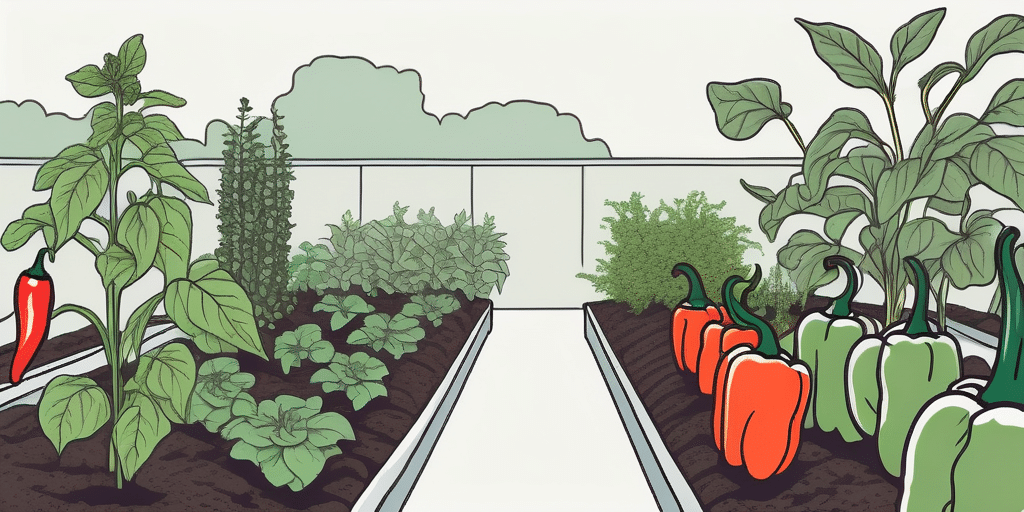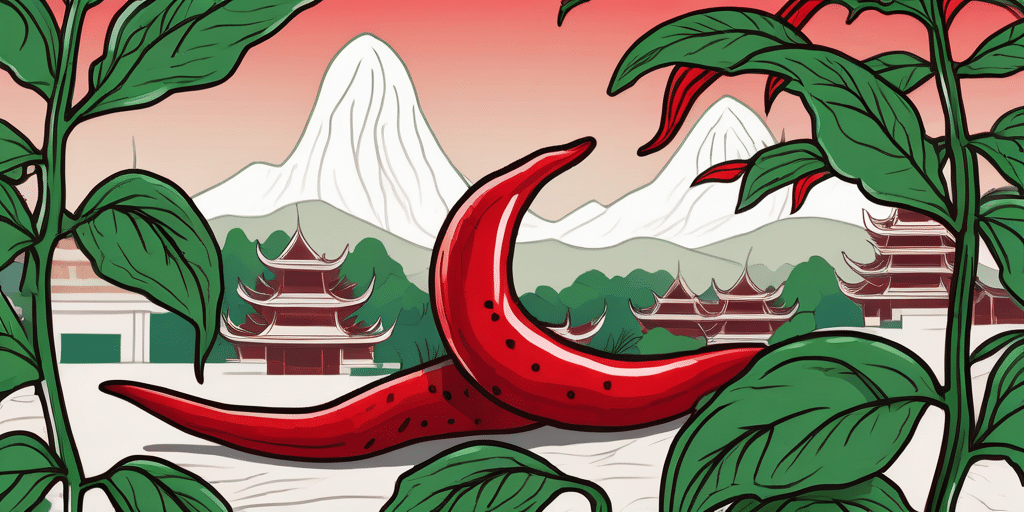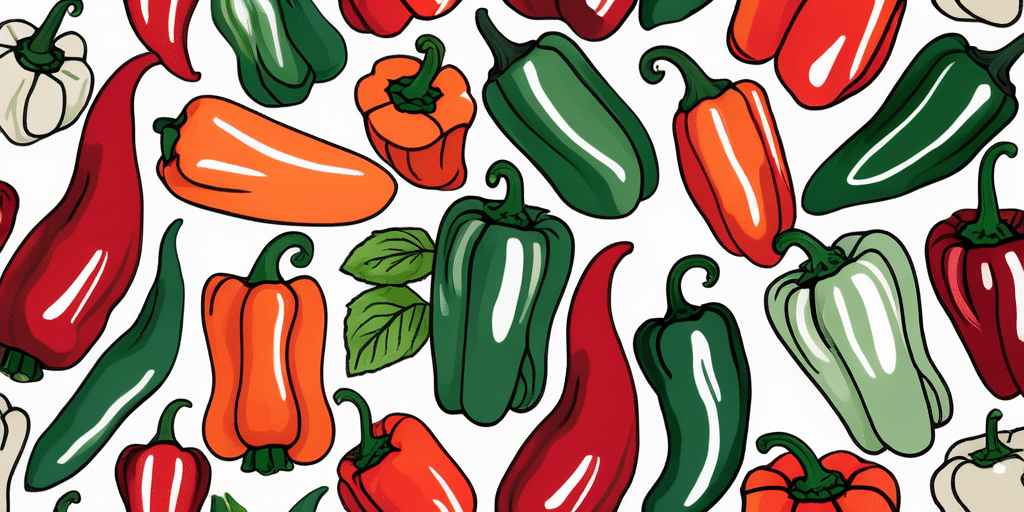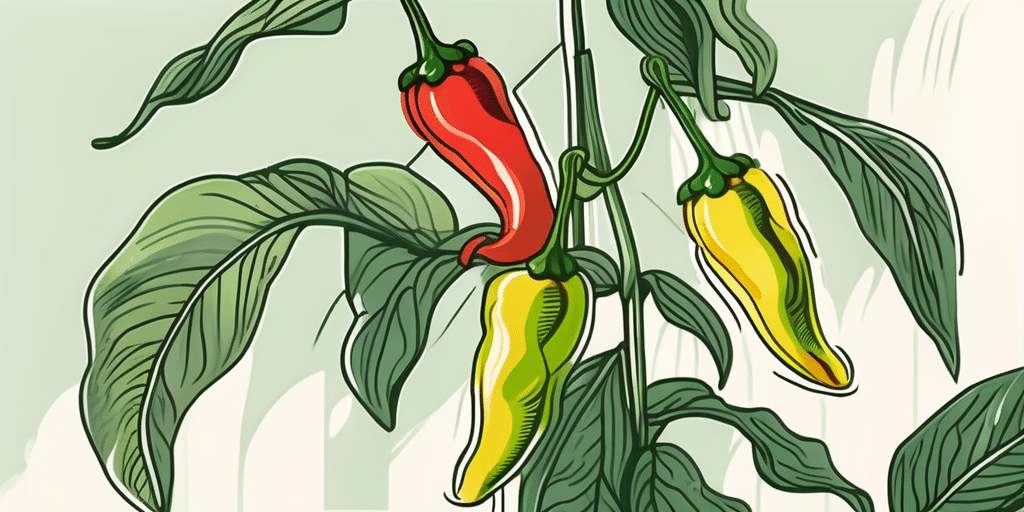Flamingo peppers, also known as Capsicum annuum ‘Flamingo,’ are a popular and vibrant variety of bell peppers. Their stunning coloration, with shades of pink, purple, and green, makes them not only a delicious addition to your meals but also an eye-catching feature in your garden. If you’re looking to grow these stunning peppers yourself, follow this comprehensive guide on how to grow Flamingo peppers from start to finish.
When to Start Flamingo Peppers
Before diving into the growing process, it’s important to know when to start your Flamingo pepper seeds. These peppers thrive in warm weather, so it’s best to start them indoors six to eight weeks before the last frost date in your area. This will give them ample time to grow and develop before being transplanted outdoors.
How to Grow Flamingo Peppers From Seed
To begin your Flamingo pepper journey, start by selecting high-quality seeds from a reputable source. Fill a seed tray or individual pots with well-draining seed starting mix, which can be purchased at your local garden center.
Sow two to three seeds per pot, approximately a quarter-inch deep. Water the soil gently, ensuring it remains moist but not waterlogged. Place the seed tray or pots in a warm location, such as near a sunny window or under a grow light.
- Keep the soil consistently moist until the seeds germinate, which typically takes around 7 to 14 days.
- Once the seedlings emerge, thin them to one per pot by carefully snipping the weaker seedlings at the soil line. This will allow the strongest seedling to thrive.
- Continue to provide bright light and keep the soil moist as the seedlings grow. Consider using a heat mat to provide warmth, as peppers prefer temperatures between 70-85°F (21-29°C) for optimal growth.
How and When to Transplant Flamingo Peppers
When the threat of frost has passed and your Flamingo pepper seedlings have reached a height of around 4-6 inches, it’s time to transplant them to their permanent location, whether that’s in your garden or in containers.
- If transplanting outdoors, choose a sunny spot with well-draining soil. Prepare the planting area by loosening the soil and incorporating organic matter, such as compost or aged manure, to improve fertility and drainage.
- Space your Flamingo pepper plants approximately 18-24 inches apart, allowing enough room for air circulation and future growth.
- If growing in containers, select pots that are at least 12 inches in diameter and have drainage holes. Fill the pots with a quality potting mix, leaving enough space to accommodate the plant’s root ball.
When transplanting, handle the seedlings with care to avoid damaging the roots. Dig a hole slightly larger than the root ball and place the seedling in the hole, ensuring it sits at the same depth as it was in the seedling container. Backfill the hole with soil, gently firming it around the plant.
How to Plant Flamingo Peppers – Spacing and Patterns
Proper spacing is crucial when planting Flamingo peppers to ensure they have enough room to grow and receive adequate sunlight and airflow. For in-ground planting, space the peppers approximately 18-24 inches apart in all directions.
If you’re growing Flamingo peppers in containers, space them at least 12 inches apart to allow for proper root development. However, keep in mind that if you’re using larger containers, you may be able to space them slightly further apart.
Some gardeners find it beneficial to plant peppers in a staggered pattern rather than straight rows. This allows each plant to have more access to sunlight and helps prevent the spread of diseases.
How Long to Grow Flamingo Peppers
Flamingo peppers take approximately 75-85 days from transplanting to reach maturity, depending on the specific variety and growing conditions. It’s important to note that the days to maturity can vary, so always refer to the seed packet or plant label for accurate information.
During the growing period, ensure your Flamingo peppers receive consistent care, including regular watering, fertilizing, and pest control, as we’ll discuss in the following sections.
How to Water Flamingo Peppers
Water is essential for the healthy growth of Flamingo peppers. Proper watering methods help prevent issues such as blossom end rot and encourage maximum fruit production. Here’s how to water your Flamingo peppers effectively:
- Water deeply when the top inch of soil feels dry to the touch. Provide enough water for it to reach the root zone without saturating the soil.
- Avoid overwatering, as peppers do not tolerate waterlogged soil. Always check the soil moisture before watering to prevent overhydration.
- Water the base of the plants rather than overhead to minimize foliage wetness and reduce the risk of foliar diseases.
- Consider using a drip irrigation system or soaker hose for more efficient and targeted watering.
Remember, maintaining consistent soil moisture is key, but allowing the soil to slightly dry out between waterings can stimulate deeper root growth.
How to Fertilize Flamingo Peppers
Providing adequate nutrition is important to ensure your Flamingo peppers thrive and produce an abundant harvest. A well-balanced fertilizer will supply the necessary nutrients. Here’s how to fertilize your Flamingo peppers:
- Before planting, incorporate organic matter into the soil to improve nutrient availability and soil structure.
- Apply a balanced slow-release fertilizer according to the package instructions. Look for a fertilizer with an NPK ratio close to 10-10-10 or 14-14-14.
- Side-dress the plants with additional fertilizer once they start flowering and fruiting, following the package instructions for rates and timing.
- Alternatively, use an organic liquid fertilizer, such as compost tea or fish emulsion, applied according to the product label.
Regular fertilization every 4-6 weeks throughout the growing season will help your Flamingo peppers stay healthy and productive.
Sunlight Requirements for Flamingo Peppers
Like most peppers, Flamingo peppers thrive in full sunlight. Aim to provide them with at least 6-8 hours of direct sunlight daily for optimal growth and fruit production. Placing them in a location with southern exposure is ideal.
If you’re growing Flamingo peppers indoors, use supplemental grow lights to ensure they receive enough light. Position the lights approximately 6-12 inches above the plants and adjust the height as the plants grow.
Soil Requirements for Flamingo Peppers
Flamingo peppers prefer well-draining soil with a pH range of 6.0 to 7.0. Before planting your peppers, prepare the soil by removing any weeds or debris and loosening it to a depth of 8-10 inches.
If your garden soil tends to be heavy or clay-like, consider adding organic matter, such as compost, to improve drainage and fertility. This will create a more favorable growing environment for your Flamingo peppers.
How to Grow Flamingo Peppers Outdoors
Growing Flamingo peppers outdoors is a rewarding experience that allows you to take advantage of natural sunlight and airflow. Here’s a step-by-step guide to growing Flamingo peppers in your garden:
- Select a sunny location in your garden with well-draining soil. Consider factors such as proximity to other plants, access to sunlight, and protection from strong winds.
- Prepare the planting area by removing any weeds or grass and loosening the soil to a depth of 8-10 inches.
- Incorporate organic matter, such as compost or aged manure, into the soil to enhance fertility and drainage.
- Plant your Flamingo pepper seedlings, following the recommended spacing of 18-24 inches apart.
- Water the plants thoroughly after planting, ensuring the soil is evenly moist.
- Mulch around the plants with organic materials like straw or wood chips to help conserve moisture and suppress weed growth.
- Monitor the plants for pests and diseases and take appropriate measures for control.
- Stake or provide support for your Flamingo pepper plants as they grow taller to prevent them from toppling over.
- Continue to water, fertilize, and care for your Flamingo pepper plants as detailed in the previous sections.
With proper care and attention, your outdoor Flamingo pepper plants will reward you with a bountiful harvest of colorful and delicious peppers.
How to Grow Flamingo Peppers Indoors
If you have limited outdoor space or live in a region with a short growing season, growing Flamingo peppers indoors is an excellent option. Here’s how to do it:
- Choose a suitable container: Select a large, sturdy container with drainage holes. A 12-inch diameter pot will accommodate one Flamingo pepper plant.
- Fill the pot with well-draining potting mix, leaving enough space for the plant’s roots.
- Plant one Flamingo pepper seedling in the center of the pot, ensuring it sits at the same depth as it was in the seedling container. Backfill the pot with soil, gently firming it around the plant.
- Water the plant thoroughly, allowing the excess water to drain out of the pot.
- Place the pot in a warm, sunny location, such as near a south-facing window or under a grow light.
- Monitor the moisture levels in the soil and water when the top inch feels dry to the touch.
- Use a balanced liquid fertilizer, following the package instructions, to provide the necessary nutrients.
- Rotate the pot regularly to promote uniform growth and prevent the plant from leaning towards the light source.
- Monitor for pests and diseases, addressing any issues promptly.
Growing Flamingo peppers indoors allows you to enjoy fresh peppers year-round, regardless of the outdoor conditions.
How to Grow Flamingo Peppers in Containers and Pots
If you’d like the flexibility to move your Flamingo peppers around or have limited garden space, growing them in containers is the way to go. Follow these steps to successfully grow Flamingo peppers in containers:
- Select a container: Choose a pot that is at least 12 inches in diameter and has drainage holes. Larger pots can accommodate multiple plants.
- Fill the pot with well-draining potting mix, leaving enough space for the plant’s root ball.
- Plant one Flamingo pepper seedling in the center of the pot, ensuring it sits at the same depth as it was in the seedling container. Backfill the pot with soil, gently firming it around the plant.
- Water the plant thoroughly, allowing the excess water to drain out of the pot.
- Place the pot in a sunny location, such as a patio, balcony, or rooftop garden. Ensure it receives a minimum of 6-8 hours of direct sunlight daily.
- Water the container-grown Flamingo peppers regularly, keeping the soil moist but not waterlogged.
- Fertilize the plants every 4-6 weeks with a balanced slow-release fertilizer or organic liquid fertilizer.
- Monitor for pests and diseases, taking appropriate measures for control.
- Rotate the pots regularly to promote even growth and prevent the plants from leaning towards the light.
Container gardening provides the opportunity to bring the beauty and flavor of Flamingo peppers to small spaces or areas with limited soil accessibility.
Flamingo Peppers Companion Plants – What to Plant With & Not Plant With Flamingo Peppers
Intercropping your Flamingo peppers with compatible companion plants can help deter pests, enhance pollination, and make the most of your garden space. Here are some suitable companion plants:
- Basil: Planting basil alongside Flamingo peppers can repel aphids and other garden pests.
- Marigold: Marigolds emit a scent that repels pests, making them an excellent companion for Flamingo peppers.
- Oregano: Oregano can deter harmful insects and attract beneficial pollinators to your garden.
- Parsley: Parsley attracts beneficial insects and provides shade to the pepper plants’ roots.
- Carrots: Carrots can help break up the soil and create space for the pepper plants’ roots to grow.
On the other hand, there are certain plants that are better kept away from Flamingo peppers. Avoid planting them next to:
- Fennel: Fennel can stunt the growth of peppers and interfere with their flavor.
- Brassicas: Plants like cabbage, broccoli, and cauliflower can compete for resources and space, affecting the growth of Flamingo peppers.
By selectively choosing companion plants and avoiding incompatible ones, you can create a harmonious and productive garden for your Flamingo peppers.
Common Flamingo Peppers Pests and Diseases
While Flamingo peppers are generally vigorous and resilient, they can still fall victim to pests and diseases. Familiarize yourself with the following common issues and ways to address them:
Pests:
- Aphids: Rinse off aphids with water or use insecticidal soaps if the infestation is severe.
- Thrips: Use sticky traps or beneficial insects, such as ladybugs, to control thrip populations.
- Cutworms: Place collars around the base of young plants to protect them from cutworm damage.
- Spider mites: Spray plants with water to dislodge spider mites or use insecticidal soap for severe infestations.
Diseases:
- Phytophthora blight: Avoid overhead watering and provide adequate spacing between plants for good air circulation.
- Verticillium wilt: Plant resistant varieties and rotate crops to reduce the risk of verticillium wilt.
- Blossom end rot: Ensure consistent watering to prevent calcium deficiency in the fruits.
- Anthracnose: Remove infected plant material and apply fungicides according to the product instructions.
Regular monitoring, prompt action, and practicing good cultural techniques, such as proper watering and adequate spacing, can help prevent and manage common pests and diseases.
How & When to Harvest Flamingo Peppers
The moment you’ve been waiting for has arrived – it’s time to harvest your Flamingo peppers! Here’s how to determine when and how to harvest them:
- Wait until the peppers reach their full size and color, whether it’s pink, purple, or green, depending on the specific variety.
- Gently hold the stem of the pepper and use a sharp knife or pair of scissors to cut it from the plant. Avoid yanking or twisting the pepper, as it can damage the plant.
- If you prefer sweeter peppers, allow them to mature further on the plant, as they will become sweeter over time. However, bear in mind that extreme heat or prolonged exposure to direct sunlight can cause the peppers to become hotter.
- Harvest regularly to encourage continuous fruit production. Leaving ripe peppers on the plant can reduce the plant’s productivity over time.
Enjoy the fruits of your labor as you bite into the crisp and flavorsome Flamingo peppers.
How to Store & Preserve Flamingo Peppers
If you have an abundance of Flamingo peppers, you may want to store or preserve them for later use. Here are some methods to keep your peppers fresh and flavorful:
- Refrigeration: Store unwashed peppers in a plastic bag or perforated container in the refrigerator’s crisper drawer for up to two weeks. Avoid washing the peppers until you’re ready to use them.
- Freezing: Wash and dry the peppers, then remove the stems and seeds. Slice or chop the peppers according to your preference, and place them in airtight freezer bags or containers. Label and date the containers and store them in the freezer for up to nine months.
- Drying: String the peppers with a needle and thread, leaving space between each pepper, and hang them in a warm, well-ventilated area until completely dry. Alternatively, use a food dehydrator or an oven set to a low temperature. Once dry, store the peppers in an airtight container away from light and moisture.
Preserving your Flamingo peppers allows you to enjoy their vibrant flavors and colors even during the off-season.
Frequently Asked Questions
Now that you have all the information you need to grow Flamingo peppers successfully, let’s tackle some frequently asked questions:
Q: How do I know when to water my Flamingo peppers?
A: Check the top inch of soil, and if it feels dry to the touch, it’s time to water your Flamingo peppers.
Q: Can I grow Flamingo peppers in containers?
A: Absolutely! Flamingo peppers thrive in containers as long as they’re provided with sufficient sunlight, proper watering, and adequate nutrients.
Q: How do I prevent blossom end rot in my Flamingo peppers?
A: Blossom end rot can be prevented by providing consistent moisture levels to the plants. Avoid wide fluctuations in soil moisture and ensure the soil is properly amended with organic matter.
Q: Are Flamingo peppers hot or sweet?
A: Flamingo peppers fall on the milder side of the pepper spectrum. However, individual taste preferences may vary, so it’s best to sample a small piece before using them in a dish.
Q: How long do Flamingo peppers take to germinate?
A: Flamingo pepper seeds typically take around 7 to 14 days to germinate. However, be patient, as germination times can vary depending on factors such as temperature and soil moisture.
Q: Can Flamingo peppers be grown in hydroponics?
A: Yes, Flamingo peppers can be successfully grown in hydroponics systems, which provide the necessary nutrients directly to the plant’s roots.
By following these guidelines and experimenting with different cultivation methods, you’ll soon be rewarded with a vibrant and delicious harvest of Flamingo peppers. Whether you’re a seasoned gardener or a novice, growing Flamingo peppers is an excellent way to spice up your garden and your meals.
Join the How to Grow Everything Community
Ready to transform your garden into a vibrant oasis of Flamingo peppers and more? Subscribe for free to How to Grow Everything and start building the garden of your dreams today! Receive personalized gardening advice tailored to your specific location, grow zone, and experience level. With our family’s commitment to providing the best gardening tips without any spam, you’ll get access to exclusive offers and a wealth of knowledge to enhance your green thumb—all 100% free. Join our community and let’s grow together!





